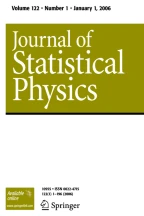Abstract
We present a detailed numerical analysis of the phase diagrams for some majority voter probabilistic cellular automata and connect the results with theory, enabling us to prove many of the observed features.
Similar content being viewed by others
References
Bennett, C.H., Grinstein, G.: Role of irreversibility in stabilizing complex and nonergodic behaviour in locally interacting discrete systems. Phys. Rev. Lett. 55, 657–660 (1985)
Bricmont, J., Van Den Bosch, H.: Intermediate model between majority voter PCA and its mean field model. arXiv:1310.0960 (2013).
Busic, A., Fates, N., Mairesse, J., Marcovici, I.: Density classification on infinite lattices and trees. Electron J. Probab. 18(51), 1–22 (2013)
de Maere, A., Ponselet, L.: Exponential decay of correlations for strongly coupled Toom probabilistic cellular automata. J. Stat. Phys. 147(3), 634–652 (2012)
Dhooge, A., Govaerts, W., Kuznetsov, YuA: MATCONT: a Matlab package for numerical bifurcation analysis of ODEs. ACM Trans. Math. Softw. 29, 141–164 (2003)
Diakonova, M., MacKay, R.S.: Mathematical examples of space-time phases. Int. J. Bifurc. Chaos 21, 2297–2304 (2011)
Dobrushin, R.L.: Markov processes with a large number of locally interacting components: existence of a limit process and its ergodicity. Probl. Inf. Transm. 7, 149–164 (1971)
Fernandez, F., Toom, A.L.: Non-Gibbsianness of the invariant measures of non-reversible cellular automata with totally asymmetric noise. Asterisque 287, 71–87 (2003)
Gielis, G., MacKay, R.S.: Coupled map lattices with phase transition. Nonlinearity 13(3), 867–888 (2000)
Gray, L.F.: Toom’s stability theorem in continuous time. In: Bramson, M., Durrett, R. (eds.) Progress in Probability: Perplexing Problems in Probability, vol. 44, pp. 331–353. Birkhäuser, Basel (1999)
Lebowitz, J.L., Maes, C., Speer, E.R.: Statistical mechanics of probabilistic cellular automata. J. Stat. Phys. 59, 117–170 (1990)
Liggett, T.M.: Classics in Mathematics: Interacting particle systems. Springer-Verlag, Berlin (2005)
MacKay, R.S.: Robustness of markov processes on large networks. J. Differ. Eqn. Appl. 17, 1155–1167 (2011)
Maes, Ch., Shlosman, S.B.: Ergodicity of probabilistic cellular automata: a constructive criterion. Commun. Math. Phys. 135(2), 233–251 (1991)
Maes, Ch., Shlosman, S.B.: When is an interacting particle system ergodic? Commun. Math. Phys. 151(3), 447–466 (1993)
Makowiec, D.: Stationary states of Toom cellular automata in simulations. Phys. Rev. E 60(4), 3787 (1999)
Mairesse, J., Marcovici, I.: Probabilistic cellular automata and random fields with i.i.d. directions. Ann. Inst. Henri Poincare B 50(2), 455–475 (2014)
Ponselet, L.: Phase transitions in probabilistic cellular automata. arXiv:1312.3612 (2013).
Spirin, V., Krapivsky, P.L., Redner, S.: Freezing in Ising ferromagnets. Phys. Rev. E 65, 016119 (2002)
Schonmann, R.H., Shlosman, S.B.: Wulff droplets and the metastable relaxation of kinetic Ising models. Commun. Math. Phys. 194(2), 389–462 (1998)
Stavskaya, O.N., Piatetski-Shapiro, I.I.: Uniform networks of spontaneously active elements (in Russian). Probl. Kibern. 20, 91–106 (1968)
Toom, A.L.: Unstable multicomponent systems. Probl. Inf. Transm. 12(3), 220–224 (1976)
Toom, A.L.: Stable and attractive trajectories in multicomponent systems. In: Dobrushin, R.L., Sinai, YaG (eds.) Multicomponent Random Systems, pp. 549–575. Dekker, New York (1980)
Toom, A.L., Vasilyev, N.B., Stavskaya, O.N., Mityushin, L.G., Kurdyumov, G.L., Pirogov, S.A.: Discrete local Markov systems. In: Dobrushin, R.L., Kryukov, V.I., Toom, A.L. (eds.) tochastic Cellular Systems, Ergodicity, Memory and Morphogenesis, pp. 1–182. Manchester University Press, Manchester (1990)
Toom, A.L.: Cellular automata with errors: problems for students of probability. In: Snell, L. (ed.) Topics in contemporary probability and its applications, Probability and stochastics series. CRC Press, Boca Raton (1995)
Toom, A.L.: Contours, Convex Sets, and Cellular Automata. Course notes from the 23th Colloquium of Brazilian Mathematics. UFPE Department of Statistics, Recife (2004)
Vasilyev, N.B., Petrovskaya, M.B., Piatetski-Shapiro, I.I.: Simulation of voting with random errors (in Russian). Autom. i Telemekh 10, 103–107 (1969)
Acknowledgments
The research of the authors has been funded by The Alfred P. Sloan Foundation, New York.
Author information
Authors and Affiliations
Corresponding author
Appendix: Connections Between Percolation Operators and Contact Process
Appendix: Connections Between Percolation Operators and Contact Process
An interesting model worth studying together with the case of \(p=0\) or \(q=0\) of the NEC PCA is the contact process. The contact process with transition rates \(\omega _r^x\) for the state \(x\) on site \(r\)
defined as in [12], is a continuous-time analogue of the percolation operators. By analysing the transition rates of the contact process one can observe that the contact process can be considered as a percolation operator with noise rate depending on the neighbourhood. More specifically, the state of site \(r\) can change to 1 from 0 only if there is at least one site in state 1 in its neighbourhood; this is exactly as for the case of the maximum function and the percolation operators. For both processes the all 0 state is absorbing.
Furthermore, if we compare parameters of continuous-time “well-stirred” approximations of the Stavskaya operator and the contact process in dimension one with one neighbour (\(n=2\)), we see that the parameter of the Stavskaya operator is a compactified analogue of the parameter of the contact process equation.
Here \(\theta _S\) and \(\theta _C\) are the proportions of 1s in the state of the Stavskaya process and in the contact process, respectively. For a formal comparison of discrete and continuous time models see [10].
Rights and permissions
About this article
Cite this article
Słowiński, P., MacKay, R.S. Phase Diagrams of Majority Voter Probabilistic Cellular Automata. J Stat Phys 159, 43–61 (2015). https://doi.org/10.1007/s10955-014-1156-y
Received:
Accepted:
Published:
Issue Date:
DOI: https://doi.org/10.1007/s10955-014-1156-y
